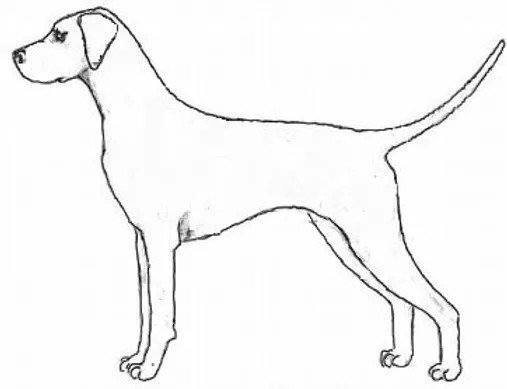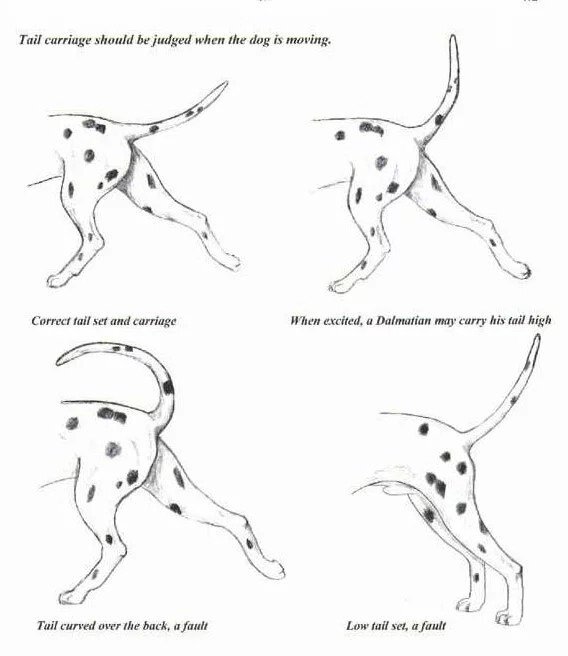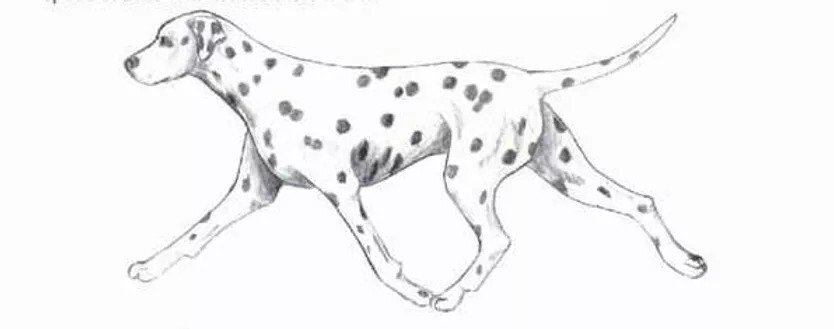The Illustrated Breed Standard of the Dalmatian
Introduction
The Dalmatian Club Of Canada has published this document for the purpose of aiding judges, breeders and fanciers to increase and enhance their understanding of the Dalmatian.
Illustrations and some of the wording used are taken, with permission, from the Illustrated Breed Standard composed by the Dalmatian Club of America. The Dalmatian Club of Canada would like to extend its sincere appreciation and thanks to the Dalmatian Club of America for allowing us this privilege.
Note: All comments not part of the Official CKC breed standard are written in Italics.
Origin and Purpose
The Dalmatian is thought to be of Central European or Mediterranean origin and is known at least from the Middle Ages. Because of its affinity for horses and capacity to travel great distances at a steady pace it came to be used as a dog to run with and guard coaches and was known as a stable dog. Even later, the Dalmatian became popular as a dog to travel with and guard horse drawn fire fighting equipment especially in the United-States.
General Appearance
The Dalmatian is a distinctively spotted dog; well balanced, strong, muscular and active, free from coarseness and lumber, capable of great endurance and speed compatible to its purpose. Clean movement and the ability to cover ground efficiently at a trot are most important in this breed.
Correct type with markings
Correct type without markings
Temperament
A lively, active dog of good demeanor.
Size
Overall balance is of prime importance and the height of dogs ideally is 22" - 24" (56 - 61 cm.), and bitches 21" - 23" (53 - 58 cm.).
Body
Top line should be level and may arch slightly over the loin. Chest should not be too wide, but very deep and capacious, ribs moderately well sprung, never rounded like barrel hoops (which would indicate want of speed). Loin should be strong and muscular.
Neck
The neck should be fairly long, nicely arched, light and tapering and entirely free from throatiness.
Deviations from correct type
The Head
Should be of a fair length in balance with the rest of the dog, exhibiting a moderate amount of stop, and not in one straight line from the nose to occipital bone. The top skull and muzzle should be approximately equal in length.
Skull: should be flat, rather broad between the ears and moderately well defined at the temple. It should be entirely free from permanent wrinkle.
Muzzle: should be long and powerful, never snipey; the lips clean, fitting the jaws moderately close.
Nose: in the black spotted dogs should always be black; in the liver spotted dogs always brown.
Mouth: The teeth should meet in a scissors bite. The incisors of the lower jaw touch very lightly the bottom of the inner surface of the upper incisors.
Eyes : Should be set moderately well apart and medium in size, round, bright, and sparkling with an intelligent expression. The eyes should be as dark as possible. In the black-spotted dogs, they should be black or brown; in the liver-spotted dogs brown or amber. Blue or partly blue eyes are undesirable and should be penalized. The rim around the eyes in the black spotted dogs should be black; brown in the liver-spotted dogs. No dog should have flesh-colored eye rims.
Ears : Should be set on rather high, of moderate size, rather wide at the base and gradually tapering to a rounded point. They should be carried close to the head and be thin and fine in texture.
NB: Although there are a number of “head” illustrations, the “head” only counts for 10 points.
Forequarters
Shoulder should be well laid, not straight, and should be clean and muscular denoting speed. It should be laid flat against the body. Leg: The forelegs be perfectly straight, strong and heavy in bone; elbows close to the body. Pastern showing a slight angle when viewed from the side and straight when viewed from the front, with a slight forward spring.
Feet
Forefeet should be compact with well-arched toes and tough elastic pads. Nails in the black-spotted dogs should be black and/or white; in the liver spotted dogs brown and/or white.
Hindquarters
Upper thigh and lower thigh muscles should be clean, powerful and well defined. Hocks should be well let down. Stifle should be moderately well bent. Feet; as for the forefeet.
Coat and Colour
The coat should be short dense and fine, slightly glossy neither woolly nor silky. The colour and markings are most important. There are two acceptable colours: white with black spots and white with liver spots. The ground colour should be pure white. Black spots should be as deep and rich as possible. Liver spots should be of a colour closer to chocolate than to tan or yellow. The spots may touch, or overlap slightly, but are preferably as round and well defined as possible, the more distinct the better; in size they should be that of a dime to a two-dollar coin, approximately 1.8cm to 3cm. The spots on the face, head, ears, legs, tail and extremities should be smaller than those on the body. The tail should preferably be spotted. The ears should be spotted, the more profusely the better; solid black or liver is undesirable.
Dalmatian spotting is the breed's most distinguished feature. Spotting helps to establish breed type, along with the structure of the dog. In the scale of points, 15 points are assigned to Coat and Colour, the same amount is assigned to gait, also an important feature of the breed. Thus both spotting and soundness are essential parts of correct Dalmatian type, and one must not be over-emphasized at the expense of the other. With spotting, a wide range of acceptability is found in the Dalmatian. It is not unusual to find variations in patterns and some intermingling of spots in acceptable range. What is a “pleasing distribution” is a subjective judgement. The outside range of acceptable pattern is determined by whether or not the pattern is so light, or so heavy, or the spotting is so intermingled as to seriously detract from breed type.
The first six of the following illustrated Dalmatians are within the acceptable range denoting breed type.
Tricolor (which occurs rarely in the breed) is a disqualification. It consists of tan markings found on the head, neck, chest, leg or tail of a black or liver spotted dog. Due to environmental conditions (i.e. Sun in summer) some bronzing of black spots and fading or darkening of liver spots on the ears and body can happen and is a natural process of coat change and are not tri-coloration.
Patches are a disqualification. A patch is a solid mass of Black or Liver colouration containing no white hair and an even, distinctive and smooth edge. Its is appreciably larger than a normal size spot. Patches are present at birth. Large masses formed by intermingling or over lapping spots are not patches. Such masses should indicate individual spots by uneven edges and/or white hairs scattered throughout the mass. Patches are visible at birth. (Non-patch puppies are born all white) Patches occur in both the liver and the black. Patches are not a dense area of spots intermingling, but rather a separate large dense, solid area of black or liver, with no white hairs in the patch area. Patches are normally found on the head, around the eyes, around the ears, and/or the eyes and occasionally appear at the base of the tail. They are very rarely found elsewhere on the body.
The Tail
The tail should reach the hock, being strong at the base and gradually tapering towards the end, free from coarseness, it should not be set on too low down and should be carried with a slight upward curve but never curled.
The tail carriage should be judged when the dog is moving.
Gait
The Dalmatian should have great freedom of movement; a smooth, powerful, rhythmic stride and action with good reach and drive. Viewed from behind, the hind legs should track the fore with no indication of the body moving at an angle to the point of direction. A short stride and/or a paddling action are incorrect.
Correct Gait : In keeping with the Dalmatian's historical use as a coach dog, gait and endurance are of great importance. Movement is steady, effortless., and ground covering. There is a powerful drive from the rear coordinated with extended reach in the front. The topline remains level. Elbows , hocks and feet turn neither in or out. The head carriage drops slightly in order to enable the extended reach in the front.
Faults
Partly flesh coloured nose. Cow-hocks. Flat feet. Incompletely coloured eye rims.
Any eye colour other than black, brown or amber.
Disqualifications
Patches; are present at birth. A patch is a solid mass of black or liver hair. Patches are appreciably larger than normal-sized spots, they are dense, brilliant in colour and have sharply-defined, smooth edges. Large colour masses formed by intermingled or overlapping spots are not patches; such masses should indicate individual spots by uneven edges and/or white hair scattered throughout. Tricolours: Any colour other than liver and white and back and white. Undershot or more than 1/8” (0.3 cm) overshot bite
Scale of Points
General Appearance 10
Size, Symmetry & Substance 10
Head and Eyes 10
Ears 5
Neck and Shoulders 10
Body, Back, Chest and Loins 10
Legs and Feet 10
Gait 15
Tail 5
Coat, Colour and Markings 15
Total 100















